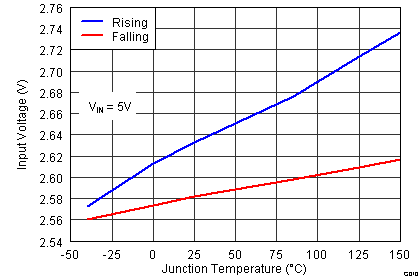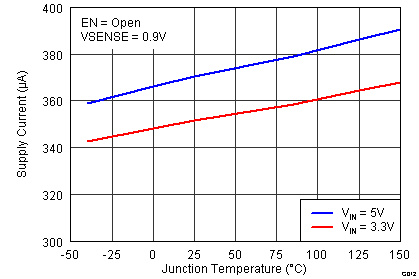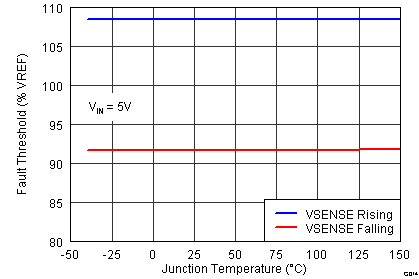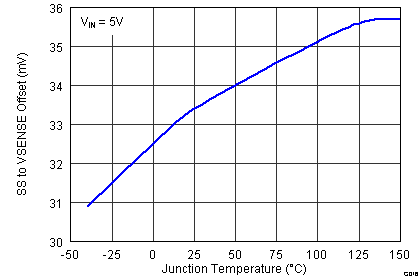SLVSAV0B April 2011 – October 2014 TPS55010
PRODUCTION DATA.
- 1 Features
- 2 Applications
- 3 Description
- 4 Simplified Schematic
- 5 Revision History
- 6 Pin Configuration and Functions
- 7 Specifications
-
8 Detailed Description
- 8.1 Overview
- 8.2 Functional Block Diagram
- 8.3
Feature Description
- 8.3.1 Fixed Frequency PWM Control
- 8.3.2 Half Bridge and Bootstrap Voltage
- 8.3.3 Error Amplifier
- 8.3.4 Voltage Reference
- 8.3.5 Adjusting the Output Voltage
- 8.3.6 Enable and Adjusting Undervoltage Lockout
- 8.3.7 Adjusting Slow Start Time
- 8.3.8 Constant Switching Frequency and Timing Resistor (RT/CLK Pin)
- 8.3.9 How to Interface to RT/CLK Pin
- 8.3.10 Overcurrent Protection
- 8.3.11 Reverse Overcurrent Protection
- 8.3.12 FAULT Pin
- 8.3.13 Thermal Shutdown
- 8.4 Device Functional Modes
-
9 Application And Implementation
- 9.1 Application Information
- 9.2
Typical Applications
- 9.2.1 Design Guide - Step-by-Step Design Procedure
- 9.2.2 Primary Side Voltage
- 9.2.3 Voltage Feedback
- 9.2.4 Selecting the Switching Frequency and Primary Inductance
- 9.2.5 Primary Side Capacitor
- 9.2.6 Secondary Side Diode
- 9.2.7 Secondary Side Capacitor
- 9.2.8 Input Capacitor
- 9.2.9 Y - Capacitor
- 9.2.10 Slow Start Capacitor
- 9.2.11 Bootstrap Capacitor Selection
- 9.2.12 UVLO Resistors
- 9.2.13 Compensation
- 9.2.14 Design Tips
- 9.2.15 How to Specify a Fly-Buck Transformer
- 9.2.16 Application Curves
- 9.3 Typical Application, Dual Output
- 10Power Supply Recommendations
- 11Layout
- 12Device and Documentation Support
- 13Mechanical, Packaging, and Orderable Information
Package Options
Mechanical Data (Package|Pins)
- RTE|16
Thermal pad, mechanical data (Package|Pins)
- RTE|16
Orderable Information
7 Specifications
7.1 Absolute Maximum Ratings (1)
over operating free-air temperature range (unless otherwise noted)| MIN | MAX | UNIT | ||
|---|---|---|---|---|
| Voltage | VIN | –0.3 | 7 | V |
| EN | –0.3 | 3.6 | V | |
| BOOT | PH + 7 | V | ||
| VSENSE | –0.3 | 3 | V | |
| COMP | –0.3 | 3 | V | |
| FAULT | –0.3 | 7 | V | |
| SS | –0.3 | 3 | V | |
| RT/CLK | –0.3 | 6 | V | |
| BOOT-PH | –0.3 | 7 | V | |
| PH | –0.6 | 7 | V | |
| PH, 10ns Transient | –2 | 10 | V | |
| Current | EN | 100 | µA | |
| RT/CLK | 100 | µA | ||
| COMP | 100 | uA | ||
| FAULT | 10 | mA | ||
| SS | 100 | µA | ||
| Operating Junction Temperature | –40 | 150 | °C |
(1) Stresses beyond those listed under absolute maximum ratings may cause permanent damage to the device. These are stress ratings only, and functional operation of the device at these or any other conditions beyond those indicated under ELECTRICAL SPECIFICATIONS is not implied. Exposure to absolute-maximum-rated conditions for extended periods may affect device reliability.
7.2 Handling Rating
over operating free-air temperature range (unless otherwise noted)| MIN | MAX | UNIT | |||
|---|---|---|---|---|---|
| Tstg | Storage Temperature | –65 | 150 | °C | |
| V(ESD) | Electrostatic Discharge | Human body model (HBM), per ANSI/ESDA/JEDEC JS-001, all pins (1) | –2 | 2 | kV |
| Charged device model (CDM), per JEDEC specification JESD22-C101, all pins (2) | –500 | 500 | V | ||
(1) JEDEC document JEP155 states that 500-V HBM allows safe manufacturing with a standard ESD control process.
(2) JEDEC document JEP157 states that 250-V CDM allows safe manufacturing with a standard ESD control process.
7.3 Recommended Operating Conditions
over operating free-air temperature range (unless otherwise noted)| MIN | NOM | MAX | UNIT | ||
|---|---|---|---|---|---|
| VI | Input voltage | 2.98 | 6 | V | |
| PO | Output power | 2 | W | ||
7.4 Thermal Information
| THERMAL METRIC(1) | TPS55010 | UNIT | |
|---|---|---|---|
| RTE (16 PINS) | |||
| θJA | Junction-to-ambient thermal resistance | 60 | °C/W |
| θJCtop | Junction-to-case (top) thermal resistance | 55.5 | |
| θJB | Junction-to-board thermal resistance | 24.9 | |
| ψJT | Junction-to-top characterization parameter | 1.0 | |
| ψJB | Junction-to-board characterization parameter | 24.9 | |
| θJCbot | Junction-to-case (bottom) thermal resistance | 9.9 | |
(1) For more information about traditional and new thermal metrics, see the IC Package Thermal Metrics application report, SPRA953.
7.5 Electrical Characteristics
TJ = –40°C TO 150°C, VIN = 2.95V TO 6V (unless otherwise noted)| DESCRIPTION | CONDITIONS | MIN | TYP | MAX | UNIT |
|---|---|---|---|---|---|
| SUPPLY VOLTAGE | |||||
| Operating input voltage | VIN | 2.95 | 6 | V | |
| Shutdown current | EN = 0V, 25°C | 2 | 5 | µA | |
| Operating current | VSENSE = 0.9V, 25°C | 360 | 575 | µA | |
| Internal undervoltage lockout | 2.6 | 2.9 | V | ||
| ENABLE | |||||
| Enable threshold | rising | 1.25 | 1.37 | V | |
| falling | 1.15 | 1.18 | |||
| Input current | Threshold - 50mV | –1.2 | µA | ||
| Threshold + 50mV | –4.6 | µA | |||
| Hysteresis | 3.4 | ||||
| VOLTAGE REFERENCE | |||||
| Reference | 3V < VIN < 6V | 0.804 | 0.829 | 0.854 | V |
| MOSFET | |||||
| High side switch resistance | BOOT- PH = 5 V | 45 | 81 | mΩ | |
| Low side switch resistance | VIN = 5 V | 45 | 81 | mΩ | |
| ERROR AMPLIFIER | |||||
| Input current | 50 | nA | |||
| Error amp transconductance | -2 µA < I(COMP) < 2 µA | 245 | uS | ||
| Error amp dc gain | VSENSE = 0.8 V | 500 | V/V | ||
| Minimum unity gain Bandwidth | 3 | MHz | |||
| Error amp source/sink | V(COMP) = 1V, 100 mV overdrive | ±16 | µA | ||
| COMP to Iph gm | I(PH) = 0.5 A | 7.5 | A/V | ||
| CURRENT LIMIT | |||||
| High side sourcing current limit | VIN = 3 V | 2 | 2.75 | A | |
| Low Side Sinking Current Limit | VIN = 3 V | –3 | –4.5 | A | |
| THERMAL SHUTDOWN | |||||
| Thermal Shutdown | 171 | °C | |||
| OT Hysteresis | 12 | °C | |||
| RT/CLK | |||||
| RT/CLK voltage | R(RT/CLK) = 195 kΩ | 0.5 | V | ||
| RT/CLK high threshold | 1.6 | 2.2 | V | ||
| RT/CLK low threshold | 0.4 | 0.6 | V | ||
| BOOT | |||||
| Boot UVLO | 2.5 | V | |||
| SS Slow Start | |||||
| Charge current | V(SS) = 0.4 V | 0.5 | 2.2 | 4 | µA |
| SS to VSENSE matching | V(SS) = 0.4 V | 35 | mV | ||
| SS to reference Crossover | 98% reference | 1.1 | V | ||
| SS discharge current (overload) | VSENSE = 0 V | 325 | µA | ||
| SS discharge voltage | VSENSE = 0V | 46 | mV | ||
| SS discharge current (UVLO, EN, thermal fault) | V(SS) = 0.5 V | 1.2 | mA | ||
| VIN UVLO to SS start time | 100 | µs | |||
| FAULT Pin | |||||
| VSENSE threshold | VSENSE falling | 91 | % VREF | ||
| VSENSE rising | 108 | % VREF | |||
| Output high leakage | VSENSE = VREF, V(FAULT) = 5.5 V | 2 | nA | ||
| Output low | I(FAULT) = 3 mA | 0.3 | V | ||
| Minimum VIN for valid output | V(FAULT) < 0.5 V at 100 µA | 1.6 | V | ||
7.6 Timing Requirements
| MIN | TYP | MAX | UNIT | ||
|---|---|---|---|---|---|
| RT/CLK | |||||
| Minimum CLK pulse width | 75 | ns | |||
7.7 Switching Characteristics
over operating free-air temperature range (unless otherwise noted)| PARAMETER | TEST CONDITIONS | MIN | TYP | MAX | UNIT | |
|---|---|---|---|---|---|---|
| PH | ||||||
| ton | Minimum on time | Measured at 10% to 10% of VIN | 130 | ns | ||
| toff | Minimum off time | V(BOOT-PH) ≥ 3 V | 0% | |||
| RT/CLK | ||||||
| Switching frequency using CLK mode | 300 | 2000 | kHz | |||
| Switching frequency using RT mode | 100 | 2000 | kHz | |||
| Switching Frequency | R(RT/CLK) = 195 kΩ | 400 | 500 | 600 | kHz | |
| PLL lock in time | 50 | µs | ||||
| RT/CLK falling edge to PH rising edge delay | 90 | ns | ||||
| SS Slow Start | ||||||
| VIN UVLO to SS start time | 100 | µs | ||||
7.8 Typical Characteristics
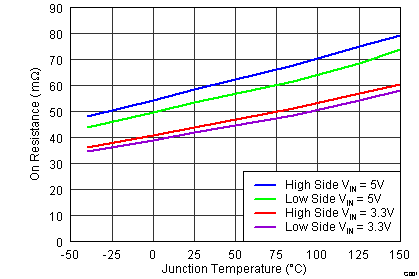
vs Temperature
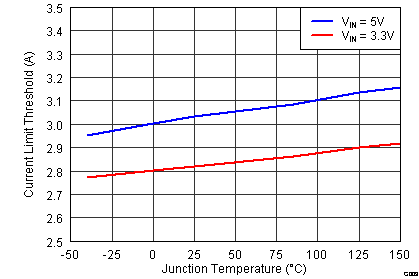
Junction Temperature
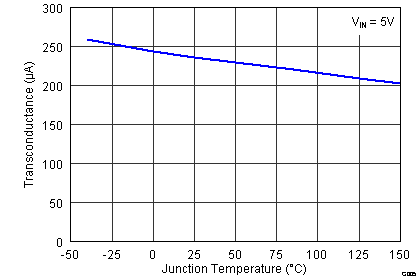
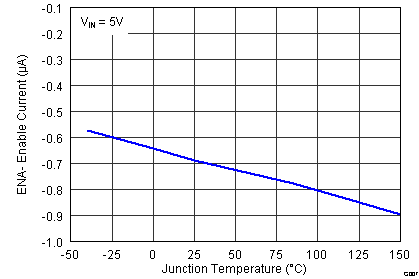
vs Temperature (VEN = Threshold -50 mV)
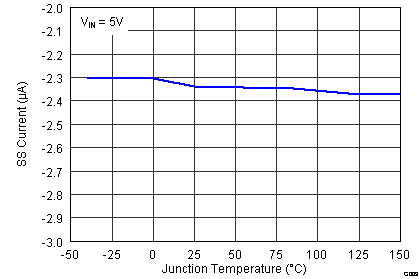
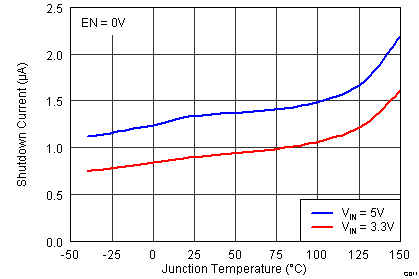
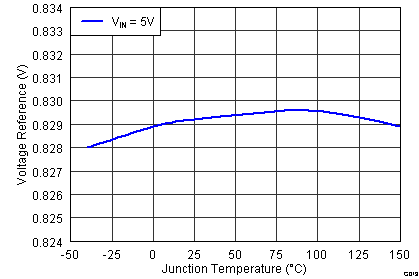
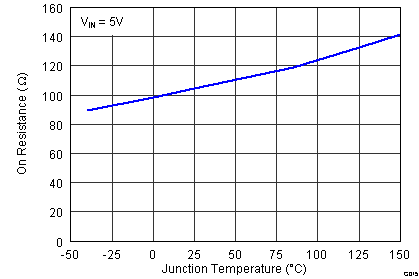
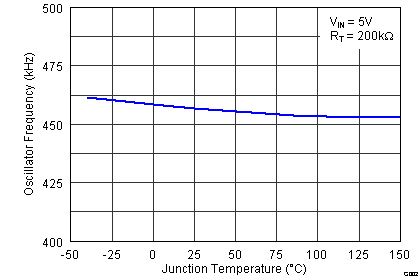
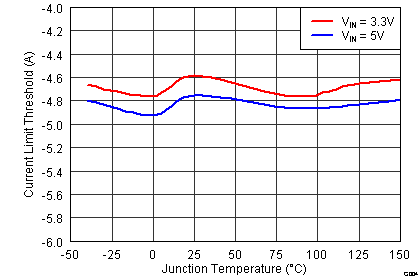
Junction Temperature
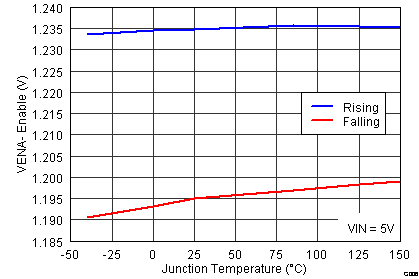
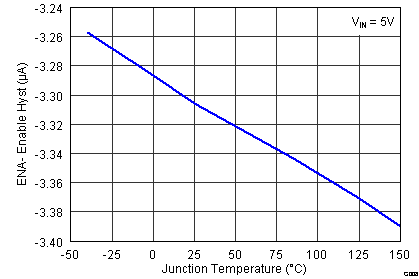
vs Temperature
